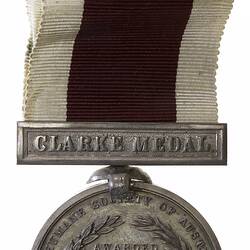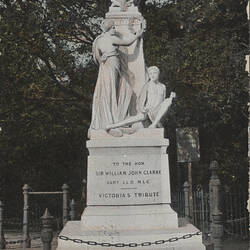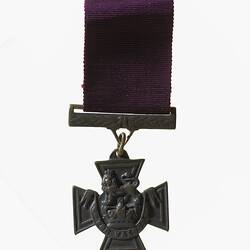Summary
Royal Humane Society of Australasia medal awarded to Frank Mazza for his act of bravery on 13 November 1914 (case number 3014). Mazza was a 26-year-old miner. He and two other miners were trapped in the Marvel Loch mine, Western Australia, following a fall of 100-200 feet. One miner was killed outright; Mazza was himself uninjured and managed to free the other surviving miner. They were rescued four days later through a tunnel dug into the mine. The Clarke medal was established through a grant to the Humane Society by Sir William Clarke in 1881. It was awarded in gold or silver. The Royal Humane Society of Australasia was founded in 1874 as the Victorian Humane Society. In 1882 it became 'The Royal Humane Society of Australasia', the first federal institution in Australia. The first object of the Society was to bestow award upon people who risked their lives to save others; the second object was to assist recipients who were disadvantaged or disabled as a result of their brave actions, or to assist their surviving dependents.
Physical Description
A silver prize medal of the Society (39 mm diameter with mount and red and white ribbon ) It features a female placing a wreath on the head of a kneeling male beneath the Southern Cross and provides the name of the winner, Frank Mazza the date 13-11-14 on the reverse within a wreath.
Obverse Description
Woman in Ancient Greek clothing standing at left placing wreath on head of young man kneeling at right below Southern Cross; around, VIRTUTE PARATUM
Reverse Description
At centre within olive wreath AWARDED / TO / FRANK / MAZZA / 13-11-14 around, ROYAL HUMANE SOCIETY OF AUSTRALASIA INSTD. A.D. 1874 (the name of recipient and date are engraved)
Edge Description
Plain
Significance
On Friday 13 November 1914 Frank Mazza, Michael O'Brien and P. Gorey (alternatively called James Jory in news reports) were working as tributers at the Marvel Loch mine, in the Southern Cross Region of Western Australia. (As tributers, they were under an agreement with the lessee or owner of the mine to pay a percentage of the value of the product taken from the mine.) About midday the men fell into a mine shaft, some 200 feet deep. At 6pm desparate knocking was heard, and rescuers calculated that the miners were located above the water line, and would have breathable air for about one week. Fifty volunteers began working shifts to rescue them. By Sunday they had driven fifty feet underground, almost half the distance required to reach the trapped miners. By Monday the miners had given the 'all right' signal to their rescuers. Finally, on Tuesday, the rescuers broke a hole into the miners' cavern and passed through food and cigarettes.They learned that Gorey had been killed instantly by the fall, and that O'Brien had been pulled uninjured from the rubble by Mazza. The miners were finally rescued at 10pm that night. Frank Mazza was later awarded the Royal Humane Society of Australasia's Clarke Medal in recognition of his bravery. -The Age, 14-18/11/1914. -D. Tout-Smith 8/10/2003.
The Clarke medal was established through a grant to the Humane Society by Sir William Clarke in 1881. It was awarded in gold or silver. -South Australian Numismatic Journal. Vol.7 [2]. April 1956, p.13. -D. Tout-Smith 6/10/2003.
The Royal Humane Society of Australasia was founded in 1874 as the Victorian Humane Society. In 1882 it became 'The Royal Humane Society of Australasia', the first federal institution in Australia. The first object of the Society was to bestow award upon people who risked their lives to save others; the second object was to assist receipients who were disadvanted or disabled as a result of their brave actions, or to assist their surviving dependents. Initially the Society also arranged swimming and lifesaving training, but other organisations later took over this role. For many years the Society was located in the Old Customs House, Flinders Street.
More Information
-
Collection Names
-
Collecting Areas
-
Acquisition Information
Transfer from National Gallery of Victoria (NGV), George H. Wannenmacher, 15 Mar 1976
-
Date Issued
1914 AD
-
Issued By
-
Sponsor
-
Awarded To
-
Place & Date of Event
Marvel Loch Gold Mine, Yilgarn Goldfields, Southern Cross, Western Australia, Australia, 13 Nov 1914
-
Inscriptions
Woman in Ancient Greek clothing standing at left placing wreath on head of young man kneeling at right below Southern Cross; around, VIRTUTE PARATUM (obverse) At centre within olive wreath AWARDED / TO / FRANK / MAZZA / 13-11-14 around, ROYAL HUMANE SOCIETY OF AUSTRALASIA INSTD. A.D. 1874 (the name of recipient and date are engraved)(reverse)
-
Series
-
Material
Silver
-
Axis
12
-
Classification
-
Category
-
Discipline
-
Type of item
-
Dimensions
100 mm (Height), 38 mm (Outside Diameter)
-
Shape
Round and ribbon
-
References
[Book] Bannister, Colin. 1996. Seven Thousand Brave Australians: a History of the Royal Humane Society of Australasia 1874-1994.
[Article] Faringdon-Davis, John. 1984. The Royal Humane Society. Australian Numismatist. 5 (August): 2-15.






